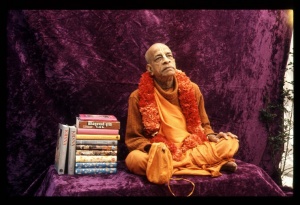BG 6.28: Difference between revisions
m (1 revision(s)) |
(Vanibot #0020 edit - link to the Version Compare feature) |
||
| Line 1: | Line 1: | ||
{{ | [[Category:Bhagavad-gita As It Is (1983+) - Chapter 06]] | ||
<div style="float:left">'''[[Bhagavad-gita As It Is (1983+)]] - [[BG 6 (1983+)|Chapter 6: Dhyana-yoga]]'''</div> | |||
<div style="float:right">[[File:Go-previous.png|link=BG 6.27]] '''[[BG 6.27]] - [[BG 6.29]]''' [[File:Go-next.png|link=BG 6.29]]</div> | |||
{{CompareVersions|BG|6.28|BG 1972|BG 1983+}} | |||
{{RandomImage}} | |||
==== TEXT 28 ==== | ==== TEXT 28 ==== | ||
<div class="devanagari"> | |||
:युञ्जन्नेवं सदात्मानं योगी विगतकल्मषः । | |||
:सुखेन ब्रह्मसंस्पर्शमत्यन्तं सुखमश्नुते ॥२८॥ | |||
</div> | |||
<div | <div class="verse"> | ||
:yuñjann evaṁ sadātmānaṁ | |||
:yogī vigata-kalmaṣaḥ | |||
:sukhena brahma-saṁsparśam | |||
:atyantaṁ sukham aśnute | |||
</div> | </div> | ||
==== SYNONYMS ==== | ==== SYNONYMS ==== | ||
<div class="synonyms"> | |||
<div | ''yuñjan''—engaging in ''yoga'' practice; ''evam''—thus; ''sadā''—always; ''ātmānam''—the self; ''yogī''—one who is in touch with the Supreme Self; ''vigata''—freed from; ''kalmaṣaḥ''—all material contamination; ''sukhena''—in transcendental happiness; ''brahma-saṁsparśam''—being in constant touch with the Supreme; ''atyantam''—the highest; ''sukham''—happiness; ''aśnute''—attains. | ||
</div> | </div> | ||
==== TRANSLATION ==== | ==== TRANSLATION ==== | ||
<div class="translation"> | |||
<div | |||
Thus the self-controlled yogī, constantly engaged in yoga practice, becomes free from all material contamination and achieves the highest stage of perfect happiness in transcendental loving service to the Lord. | Thus the self-controlled yogī, constantly engaged in yoga practice, becomes free from all material contamination and achieves the highest stage of perfect happiness in transcendental loving service to the Lord. | ||
</div> | </div> | ||
==== PURPORT ==== | |||
= | <div class="purport"> | ||
Self-realization means knowing one's constitutional position in relationship to the Supreme. The individual soul is part and parcel of the Supreme, and his position is to render transcendental service to the Lord. This transcendental contact with the Supreme is called ''brahma-saṁsparśa''. | |||
</div> | |||
<div | <div style="float:right; clear:both;">[[File:Go-previous.png|link=BG 6.27]] '''[[BG 6.27]] - [[BG 6.29]]''' [[File:Go-next.png|link=BG 6.29]]</div> | ||
__NOTOC__ | |||
</div> | __NOEDITSECTION__ | ||
__NOTOC__ | |||
Revision as of 22:04, 7 December 2017

A.C. Bhaktivedanta Swami Prabhupada
TEXT 28
- युञ्जन्नेवं सदात्मानं योगी विगतकल्मषः ।
- सुखेन ब्रह्मसंस्पर्शमत्यन्तं सुखमश्नुते ॥२८॥
- yuñjann evaṁ sadātmānaṁ
- yogī vigata-kalmaṣaḥ
- sukhena brahma-saṁsparśam
- atyantaṁ sukham aśnute
SYNONYMS
yuñjan—engaging in yoga practice; evam—thus; sadā—always; ātmānam—the self; yogī—one who is in touch with the Supreme Self; vigata—freed from; kalmaṣaḥ—all material contamination; sukhena—in transcendental happiness; brahma-saṁsparśam—being in constant touch with the Supreme; atyantam—the highest; sukham—happiness; aśnute—attains.
TRANSLATION
Thus the self-controlled yogī, constantly engaged in yoga practice, becomes free from all material contamination and achieves the highest stage of perfect happiness in transcendental loving service to the Lord.
PURPORT
Self-realization means knowing one's constitutional position in relationship to the Supreme. The individual soul is part and parcel of the Supreme, and his position is to render transcendental service to the Lord. This transcendental contact with the Supreme is called brahma-saṁsparśa.